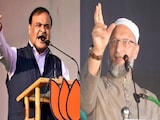The BJP won the last UP election in a landslide. A victory margin so big that many, if not most, observers sense that it cannot be overcome by the Opposition. Polls forecast that even though the BJP may lose 100 seats (from 325 down to 225 seats out of the 403 in UP), it would still win with a clear majority.
Figure 1
Figure 2
Figure 3
However, the BJP has another distinct advantage as it fights this election - the Opposition has been so divided that the BJP can survive a larger than normal swing away in its popular vote (see Figure 4). If it faced a near-unified Opposition, the BJP would lose with a swing away of 5%, but with the Opposition fragmented the way it is, the swing away from the BJP would need to be significantly higher. So, how many voters can the BJP lose while remaining the winner of the election?
Figure 4
Figure 5
Additional unease within the BJP is that despite its record 52% vote in the Lok Sabha elections, there is a sharp drop in its vote in Assembly elections (see Figure 6) compared to Lok Sabha elections. This drop used to be around 14%, but over the last few years - before and after the 2019 Lok Sabha elections - the BJP has dropped 21% in the 10 assembly elections held one year before and since the Lok Sabha elections.
Figure 6
If this pattern is repeated in UP, the BJP vote would drop to 30.5% in these elections - a swing away of -10% from its current 41.5% vote it won in 2017 - a swing that would be devastating for the party.
Nevertheless, the bottom line for the BJP is that it has entered the contest in this election with an almost unprecedented foundation vote coupled with a large margin of victory because of a deeply-divided Opposition. The problem it faces is that the state has gone through a deep financial crisis because of Covid - it doesn't really matter if the BJP handled Covid well or not, people have suffered terribly. Coupled with a rise in prices - again, it doesn't matter whether it is a result of external factors (like the rising price of oil) - this has generated anger in the population, and few governments in history have managed to prevent a swing away after these crises. The main target for the BJP is to prevent the swing away from being more than 7% - because more than that means it could lose power.
-
choose your destination
-
News Updates
-
Featured
-
More Links
-
Follow Us On















